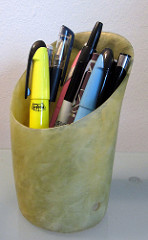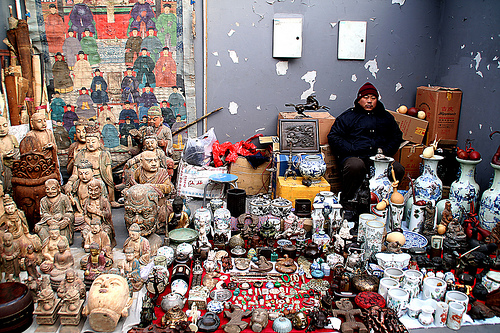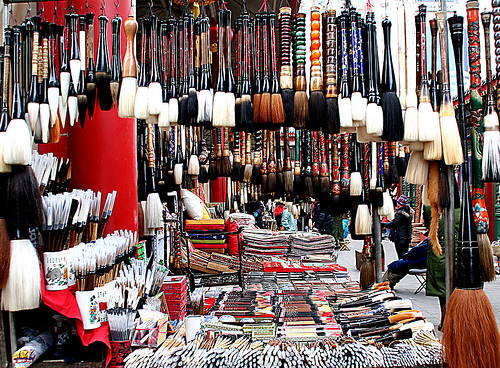Check out our Top Rewards Cards to boost your points earning and travel more!
When I travel, I like to bring back a single special item that really represents the trip as a whole to me. For example, for Egypt it was a hand-woven Persian carpet. I’m considering something art-related for China. Two things that come to mind are a Chinese classical-style painting (like this) of a mountain/landscape scene or possibly a jade carving/statue of some sort. Taking everything into consideration (availability of something truly unique, my potential inability to determine value on the street, chance of buying a knockoff thinking it is the real thing, weight/size of the item and ability to get it home, etc) which item might you recommend for my “trophy”? Also, which city (and market or vendor, if you have knowledge that granular!) would be the best place to purchase the item? I’m willing to spend as much as $1000 on such an item, but obviously the cheaper, the better. I’d also consider bringing back multiple items as long as they don’t exceed my rough $1000 budget when combined.
As I have seen you mention in a previous blog post, I am well aware of the paradox where we can often buy many foreign goods in the US cheaper than in the country of manufacture! I have also learned quickly in my earliest travels about how hard it is to get something truly unique these days. More than once I bought something on a trip thinking it was unique only to see it for sale back here in the States! Curse you, Pier 1!
 This question is a doozy. The quick answer is to buy something that you love because of its qualitative appeal to you, not because of its purported quantitative value. Whatever you buy in China right down to a bottle of beer has a shockingly high chance of being a fake. But when your purpose is to acquire an object you will enjoy, re-sale value may be irrelevant. A personal example is a ‘Qing dynasty jade’ hair ornament The Rapid Traveler uses as a pencil holder. He bought it from one of the vendors at Panjiayuan Market in Beijing, not one of the formal stalls, but one of the people who lay their wares for the day on a blanket. He assumed the parts about ‘Qing Dynasty’ and ‘jade’ were poppycock, but negotiated a price acceptable for the object.
This question is a doozy. The quick answer is to buy something that you love because of its qualitative appeal to you, not because of its purported quantitative value. Whatever you buy in China right down to a bottle of beer has a shockingly high chance of being a fake. But when your purpose is to acquire an object you will enjoy, re-sale value may be irrelevant. A personal example is a ‘Qing dynasty jade’ hair ornament The Rapid Traveler uses as a pencil holder. He bought it from one of the vendors at Panjiayuan Market in Beijing, not one of the formal stalls, but one of the people who lay their wares for the day on a blanket. He assumed the parts about ‘Qing Dynasty’ and ‘jade’ were poppycock, but negotiated a price acceptable for the object.
The Rapid Traveler has a friend in Shanghai who became wealthy in auctions of government assets and then went into the art auction business as a hobby. He has spent years in study and even the experts admit to him that the fakes are so skillful that they too are sometimes duped. A novice is almost certain to be duped, no matter how much people swear by ‘their’ vendor that is trustworthy (remember that tourists are masters of self-deception, especially when they have parted with cash).
Add to that, your request is for the high-end, and a lot of Chinese art and crafts are typically not appealing to Western sensibilities. The austere landscape paintings are nice, but difficult to distinguish quality, while carvings out of jade and stone often seem tacky (visit Chinese restaurants in any country for specimins). Typically the things that stand out to The Rapid Traveler as unique are at the low-end, tucked in the corner of some dusty cabinet at a tourist site vendor.
Here are some suggestions, but most important is that, though you will see many things over and over, if you fall in love with something, buy it on the spot because that’s exactly the thing that you’ll never see again.
Since you are starting in Beijing, spend some time wandering Panjiayuan, preferrably on a weekend. About 75% of what you see will reappear throughout your trip, but the selection is widest here. Then go over to the Pearl Market (across from the Temple of Heaven), which is better for this than the Silk Market. The lower floors have stalls with low-end bric-a-brac; quality and price increases with elevation until you reach the top for high-end items. A final walk to the roof affords a great view of the Temple of Heaven. With these two you will have seen about 90% of what is out there.
Following Panjiayuan and Pearl, take the pressure off and go about your regular plan in Beiing, Xi’an and Chengdu, peeking at the countless vendors tucked in the nooks of museums, temples and monuments, relying on chance. The souvenirs that The Rapid Traveler likes turn up in the oddest places, even encountering some G.I. Joe action figures with mismatched heads and bodies at a temple vendor. Buddhist pilgrimmage sites like Emei Shan have lots of goodies.
One appealing item that turns up here and there is brick tea embossed in various designs.
You’ll probably find something along that way that catches your eye, but don’t let the search overshadow the trip.
Note on tour groups: to the frustration of many, spend an inordinate time in dedicated tourist shops in exchange for the comparatively low package prices to China. These are typically under the guise of ‘factory,’ as in a ‘jade factory,’ with table and dusty implements and maybe one or two artisans for show. These are generally in remote locations from which there is no easy escape, and guides disappear to lounges with screens that show the sales totals: when the sales taper off the guide reappears. These are not worthwile for individual travelers, with possibly one exception, the ‘Peasant Paintings’ of Huixian outside Xi’an. The colorful style appeals to non-Chinese tourists, but it is hard to distinguish what is indigenous and what is playing to the crowd. Pandas appear nowhere else in traditional art and are not local to that region, so you be the judge. But the paintings are fun.
Check Out Our: Top Rewards Cards ¦ Newsletter ¦ Twitter ¦ Facebook ¦ Instagram


